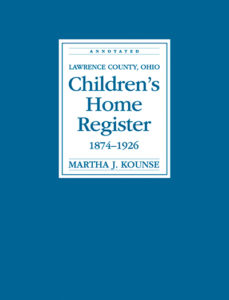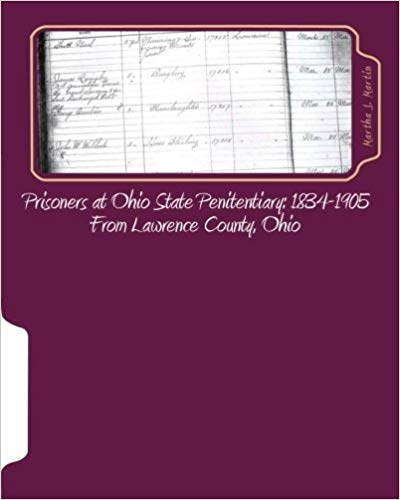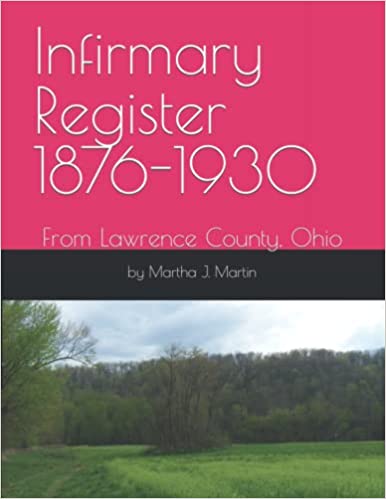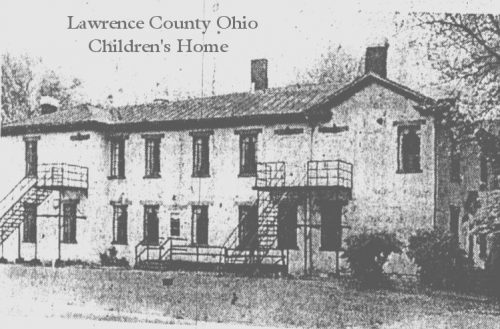Lawrence County, Ohio, Children’s Home
Researched and copyrighted by Martha J. Martin-Kounse
PART ONE – HISTORY
The Lawrence County Children’s Home was also called the Orphans Home. It opened in 1874 in a large brick house on Front Street, near Railroad Street, and remained there from 1874-1878.
On Feb. 4, 1874, a meeting was held at the old Spencer church on 5th and Center Streets, at which time Cyrus Ellison presided, and E. Bixby was the Secretary. The meeting was led by Rev. A.G. Byers, who spoke of the need for an orphanage, I assume to help the children who were innocent victims of the Civil War and diseases.
A committee comprised three people from each ward of the city of Ironton. They had to wait on the public for subscriptions to help start and maintain the home. The people saw the need and came to help, as $1,500 was raised on the very first day.
There were children whose parents were ill or who had died, and there was no means of shelter for numerous children. Children were sometimes seen roaming the streets, begging for food. Many mothers and fathers were in the Infirmary, too ill to care for their young offspring.
In 1878, the Children’s Home was moved to Vernon Street, just east of Ninth Street in Ironton, Ohio, where the Juvenile Home is now located. [Martha’s note: It has since been torn down, and a new Holiday Inn now sits on that property.] Its structure was a three-story white stucco that used to be easily seen from State Route 52.
This building was originally the home of J. N. THOMAS and was completely remodeled in about 1933. The same year, the County Commissioner took over the Home and appointed three Trustees to manage it. They were: C. Ensinger, A. T. Dempsey, and T. I. Murdock.
The first Trustees were:
- S. W. Dempsey
- Cyrus Ellison
- E. Bixby
- C. B. Egerton
- D.Nixon
- J. A. Witman
- W. W. Johnson
The first lady managers were:
- Miss Sarah Bartram
- Mrs. F. D. Norton
- Mrs. R. Mather
- Miss Woodrow
- Mrs. Thomas Johns
- Mrs. W. D. Kelly
- Mrs. C. Ellison
- Mrs. George Willard
- Mrs. E. Nigh
- Mrs. J. Prichard
In 1938, the Home was under Miss Lillie A. Sheppard, Matron in charge. The first Matron was Miss Mary E. Vincent, who held the position for six years. Other matrons were:
- Mrs. E. Grant
- Mrs. M. E. Carpenter
- Mrs. F. Osterhouse
- Miss Lola Zell
- Miss Sara F. Johnson
- Miss Nevada M. Shingler
- Miss Sara Rogers and others
Annotated Children's Home 1874- 1926

You can purchase this through Little Miami Publishing Co.
This book was researched and written by Martha J. (Kounse) Martin.
PART TWO – RECORDS AND HOW TO OBTAIN THEM
The Lawrence County, Ohio, Children’s Home records are microfilmed only from 1874-1929. That microfilmed copy is available:
- Briggs Lawrence County Public Library, Hamner Room Room in Ironton, OH.
- Familysearch.org
- Ohio Historical Society, Columbus, Ohio.
- Ohio University, Alden Library, Athens, Ohio.
This film, in some parts, is extremely difficult to read and, in some places, impossible. I have copied each page, add annotations, and have them available in book form. You can purchase it through Little Miami Publishing Company, a total of app. 250 pages.
PART THREE –
Every child has an entry (except for a couple) under their name with some or all of the following information:
1. Child’s Name
some children have another name besides the surname, i.e., the mother’s maiden name.
2. Date admitted (some dates are blank)
includes where they were accepted from (Twp, Probate Court, Infirmary, etc.). Sometimes the children were abandoned by their parents, and relatives would bring them in, but because of hardships, they could no longer provide for the child(ren). The Infirmary records are also on microfilm and can be viewed similarly to the children’s Home.
3. Father’s Name
Most entries list the father’s birthplace, birth date, and where the father is now. If he is dead, it usually will give his death date and what he died of.
If he was in the Civil War, it usually gives the company, regiment, and War he served. This is beneficial info, esp. when the father deserted the children, and nothing is known of him.
Some fathers were in prison, which is recorded here. You can then order microfilm from the L.D.S. church on the pent. Records under Ohio-Franklin County-Columbus. It gives the year in the Children’s Home records so you can order the correct film.
The penitentiary records usually give when the person was admitted, the crime committed, the length of time served, whether they died there, their age, where they were born, eye color, height, hair color, complexion, what kind of personality they had, and their family info (siblings, parents, children, etc.). It also states whether they owned land and where it was located.
4. Mother’s Name
Usually gives maiden name, religion, parent’s name, siblings to mother, places of residence, birthplace, birth date, if dead, what she died of, and other children she has. The same thing for the father is written about the mother, except for the service records.
5. Date of child’s birth and where born
6. Age of child at the time of admittance
7. Father and mother’s nativity
8. Where parents are residing
9. Other siblings
(including half and step-siblings), uncles, aunts, grandparents, cousins, etc. Usually gives residence of relatives.
10. Who took the child, and if a relative took it, what relation were they to the child?
Sometimes the child was taken out-of-state-it may give the locality where the child was born. Several children were taken to TX, FL, WV, and KY. Many were taken to Boyd Co, KY, and Monroe Co, WV.
11. Date the child was taken out of the Home by other people.
If they were not related, the person taking the child would be required to sign a contract which the Home referred to as Indenture. If the child did not work out satisfactorily for the person taking them, they could be returned to the Home. Boys would be taken to work on the farm, in the fields, etc. The girls would help the mother with more minor children, cooking, cleaning, etc.
The children often would not work out due to illnesses, small stature, and unruliness. Other times the parent’s health or financial future would improve. Sometimes the parents would receive a pension from the War. When the child was returned, which happened a lot, the record gives the date the child was born and the reason.
12. Most entries of each child would have updated information about the child, including a few days to a few years after the child was dismissed from the Home.
i.e. Sarah ADAMS; admitted 22 Aug 1914; Father – Granville ADAMS; Mother – Mary ACKINSON; Sarah b. 3 Jan 1902; Father d. Oct 1907 of consumption; Mother d. Sept. 1909 of consumption.
An aunt, Kate WALTERS, of Sheridan, OH, had been keeping the children (see Ethel ADAMS), and they have some other relatives living at Sheridan (not named).
She was placed with Mr. & Mrs. T. B. GREENSLAIT of Kenova, WV R.F.D. #1 on 10 Sept 1910; Married to P. W. HAMMOND, of Wyandot Michigan on 17 Mar 1919 and was married in Columbus, OH.
13. Sometimes, the records give who recommended the person that took the child.
14. Tells what Company and Regiment the father was in if he served in the C.W.
15. Gives information on whether the parent’s habits were good or bad. i.e., drinking or going to church.
16. Listed illnesses children had.
In 1880, measles was going around in the Children’s Home.
17. Some records mentioned that the child was illegitimate and who the father was supposed to be.
i.e., a child b. 1885 at Infirmary was illegitimate. States father was a native of Lawrence County, Ohio, and is now (Dec 1887) living in Kansas.
Prisoners at Ohio State Penitentiary from Lawrence County, Ohio
 You can order this book on Amazon.com.
You can order this book on Amazon.com.
Written and researched by Martha J. Martin.
PART FOUR –
1. Girl’s or Boy’s Industrial School
2. Cleveland Protestant Orphan Asylum (1891)
3. Religious Denomination of parents
4. Parent Relatives
5. If one or both parents were deceased, in most cases, it names the cause of death.
6. If surviving parent re-married, it usually gives the name of the step-parent, date of marriage, where they married, where the family is now living, and the step-parent’s occupation.
7. Institution for Feeble-Minded Youths, Orient, OH (near Columbus) (these records are unavailable).
8. Blind School, Columbus, Ohio (available at familysearch.com).
9. County Infirmary, Ironton, Ohio, These records are available in my book on amazon.com and are on microfilm in Briggs Library, Hamner Room, Ironton, Ohio; Familysearch.org; Ohio University, Alden Library, Athens, Ohio; and Ohio Historical Society.
Sometimes children were brought from the County Infirmary, as they were well enough to go home after being treated for an illness, but sometimes the mother was still in the Infirmary, and the father could not care for the child or children. In other instances, some children were born in the Infirmary, sent to the CH, then sent back to the Infirmary b/o poor health.
10. Buried Woodland Cemetery, Home Lot, Ironton, Ohio. The burial index is available on this website here. If you find someone in the burial index, call or visit the Hamner Room in Briggs Library in Ironton, Ohio, for additional information. (I heard there were graves found on the property of the old Poor House behind Woodland Cemetery when they were constructing a new building.-mm).
When a date was recorded in the Children’s Home, that gives you a clue where to search for additional records, such as the Health Dept., depending on the date. From there, you can continue your search by looking up newspaper articles, esp. Ironton Register (as it was once called) to follow the children’s movement. Example:
Abandoned Boy admitted 28 Jan 1893 (no name listed in CH Register) and was left at Centre House. I searched the 1893 Ironton Register and found on 9 Feb 1893 a Miss Nina BLACKWELL d/o John was brought up on charges of abandoning her baby. The article goes on to state that it was the baby left at Centre House. (That really pinpointed it to the right child).
She pleaded “Not Guilty”, but was held over with a fine of $100.00. I stopped my search there, but it gave me the name of the child, the mother, and the grandfather, so if I wanted to, I could continue my search in other areas, such as court records at the Clerk’s Office.
11. Cincinnati, Ohio, Children’s Home. I noticed a lot of children were sent there in the year 1891. It seems like the matron sent children to certain places at different years.
12. Sometimes, the child would run away from the Children’s Home.
ie. Harry BARE has admitted 4 Dec 1895; father General BARE; mother Josephine SANDS; Sister Alice (twin) b. 23 Mar 1887 in Ironton; Father lives at Corner of Pine & 11th Sts; Mother d. 1893 and b.1854 at Gallipolis; Parents habits were good; Father then married Emily BALL in 1895 and only lived with her a few weeks; Harry was given ‘on trial’ a few times, but always returned; Harry ran away to Uncle SANDS, W. Ironton 22 Jan 1901; Harry in CA Jan 1909.
13. One Child was Stolen (John BARKER)
14. In most cases, children were given back to their parents after circumstances improved at home.
15. Adopted (this is probably the most helpful part of the Children’s Home Register because adoption papers are so hard to trace.)16. Mt. Carmel Hospital Columbus, Ohio
17. Boys Military School Washington, DC.
18. Division Of Charity (Sometimes called D&C)
19. Gallia County, OH Infirmary and Children’s Home. (on microfilm at Gallipolis, Ohio, Library)
20. Scioto County, OH Children’s Home. (microfilm at Portsmouth, Ohio, Library)
21. Children’s Hospital in Cincinnati, Ohio.
22. Buried in Kelly’s Cemetery, Lawrence County, Ohio.
23. Ohio Soldiers & Sailors Home, Trumbull County, Sandusky, Ohio.
Infirmary Register
 Click Here to Purchase the Infirmary Register 1874-1930. Available through Amazon.
Click Here to Purchase the Infirmary Register 1874-1930. Available through Amazon.
Written by Martha J. Martin
PART FIVE – ABOUT THE OHIO SOLDIER’S & SAILOR’S HOME MICROFILMED COPY
The Ohio Soldiers’ and Sailors’ Home at Sandusky, Ohio, was opened in November 1888, when it accepted its first resident. Applicants must have been living in Ohio but did not necessarily need to have served in Ohio during various wars. The home is still in full operation, now known as the Ohio Veterans Home (not sure of this now at the current date-mm).
The Ohio Historical Society has microfilmed the old Home records, which are fully indexed. Each entry is identified by Admission Number and recorded chronologically in the records by that number.
The headings on each page are:
MILITARY HISTORY:
- Time and place of each enlistment
- Rank
- Company and Regiment or Vessel
- Time and place of discharge
- Cause of discharge
- Rate of Pension
- Disability
- Whether they can read or write
DOMESTIC HISTORY
- Where and when born
- Religious belief
- Height
- Complexion
- Color of Eyes
- Color of Hair
- Occupation
- Residence after discharge
- Family still living
- Name and P.O. address of the nearest relative
HOME HISTORY
- Cottage
- Date of admission and re-admission
- Appointments
- Date of discharge
- Cause of discharge
- Date of death
- Cause of death
GENERAL REMARKS:
- Admission paper number
- Army discharge
- Certificate of service
- Pension certificate number
Effects:
- Labor money
- Pension money
- Imbecile Asylum
- Ohio Institution for the Deaf (FHC #0929256; starts with 1829-1869) Included on this microfilm is the name of the child, residence (town, county state); date of birth; date of admittance; cause of deafness; deaf-mute relatives; parents, etc.; discharged and remarks (has date and cause of death, if applicable)


0 Comments
Trackbacks/Pingbacks